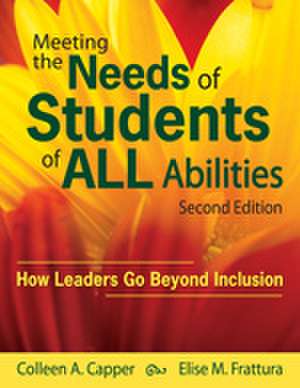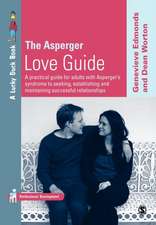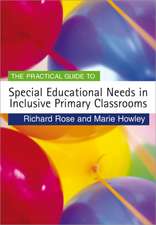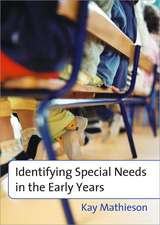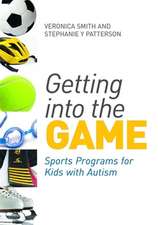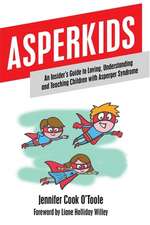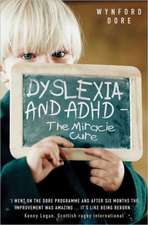Meeting the Needs of Students of ALL Abilities: How Leaders Go Beyond Inclusion
Autor Colleen A. Capper, Elise M. Fratturaen Limba Engleză Paperback – 13 ian 2009
Meeting student needs shouldn't mean isolation from peers. This step-by-step handbook offers practical strategies for administrators, teachers, policymakers, and parents who want to shift from costly special learning programs for a few learners to excellent educational services for all students. Readers will find practical strategies for:
- transitioning from separate programs to effective services
- establishing broad standards as prerequisites for student success
- using the law and funding to meet student needs
- preparing for the journey of change.
The second edition includes the latest research on integrated and socially equitable schools, a greater emphasis on social justice, and a new Equity Audit Questionnaire.
Preț: 312.63 lei
Nou
Puncte Express: 469
Preț estimativ în valută:
59.82€ • 62.62$ • 49.79£
59.82€ • 62.62$ • 49.79£
Carte tipărită la comandă
Livrare economică 31 martie-14 aprilie
Preluare comenzi: 021 569.72.76
Specificații
ISBN-13: 9781412966955
ISBN-10: 1412966957
Pagini: 192
Dimensiuni: 216 x 279 x 13 mm
Greutate: 0.52 kg
Ediția:Second Edition
Editura: SAGE Publications
Colecția Corwin
Locul publicării:Thousand Oaks, United States
ISBN-10: 1412966957
Pagini: 192
Dimensiuni: 216 x 279 x 13 mm
Greutate: 0.52 kg
Ediția:Second Edition
Editura: SAGE Publications
Colecția Corwin
Locul publicării:Thousand Oaks, United States
Recenzii
"A timely and friendly read with useful surveys, self-evaluations, and stories. The book brings together current trends and educational issues, including Response to Intervention, bullying, professional learning communities, the planning and change process, and the school’s responsibility in providing for at-risk students."
"This book provides a clear road map for everyone who is interested in changing schools to be responsive to ALL students. School personnel, school boards, and individual educators will be challenged to think courageously about how schools should operate for every student who comes through the classroom door."
"Offers specific strategies for creating environments where children can work together and learn from each other regardless of their abilities."
"Brings a creative, well-researched perspective to schools that is inclusive in exciting ways. I strongly recommend it for use in graduate courses in educational administration and to administrators who want to put their caring and commitment into effective action."
"This book provides a clear road map for everyone who is interested in changing schools to be responsive to ALL students. School personnel, school boards, and individual educators will be challenged to think courageously about how schools should operate for every student who comes through the classroom door."
"Offers specific strategies for creating environments where children can work together and learn from each other regardless of their abilities."
"Brings a creative, well-researched perspective to schools that is inclusive in exciting ways. I strongly recommend it for use in graduate courses in educational administration and to administrators who want to put their caring and commitment into effective action."
Cuprins
List of Handouts
Preface to the Second Edition
Acknowledgments
About the Authors
Introduction
Part I. Shift From Programs to Services
1. Setting the Stage: The Social and Legal Impetus for Services Rather Than Programs in Integrated, Socially Just Schools
2. Shifting From Programs to Services: Where to Begin?
First Stage: Ask Necessary Questions
Second Stage: Establish a School Service Delivery Team to Initiate Change
Third Stage: Shift Personnel Roles to Meet Student Needs
3. Leading for Social Justice at the School and District Levels
Primary Leadership Characteristic: Inclusive Social Justice and Equity Are the Leader's Core Identity
Leading for Social Justice at the District Level
Traditional Roles of Central Office Administrators Impede Change
Transforming From Centralized Leaders to Social Justice Leaders
Part II. Establish Standards for Integrated, Socially Just Schools and Districts
4. Standards for Physical and Emotional Safety: Prerequisites for Student Success
Standard 1: Make Physical and Emotional Safety Central to All Aspects of the School
Standard 2: Establish a Culture of Inclusivity and Visibility
Standard 3: Take Harassment Seriously
Standard 4: Cocreate Antiharassment Policy and Strategies
Standard 5: Integrate Antiharassment Into the Curriculum
Examples of an Antiharassment Policy in Practice
5. Standards for Student Behavior
Standard 1: Be Conscious of How We Label Students; Student Behavior Is Relative
Standard 2: Hold High Expectations for Student Behavior in a Context of Care
Standard 3: Develop and Consistently Implement Schoolwide Discipline Policies That Have Individually Designed Consequences and Positive Incentives
Standard 4: Provide Early Intervention
Standard 5: Involve Students in All Aspects of Intervention
Standard 6: All Staff Must Understand That All Behavior Is an Attempt to Communicate
Standard 7: All Staff Must Have Similar Expectations and Strategies for Student Behavior
Standard 8: View Teaching and Learning Appropriate Behaviors as a Long-Term Process
Standard 9: Staff Must Use Proactive Strategies for Students Who Need More Intense Support
6. Quality Instruction and Assessment: The Foundation for Integrated, Socially Just Schools
Strategy 1: Focus on Instruction: Ensure That ALL Students Have Access to Quality Teaching
Strategy 2: Get It Right the First Time: Interventions and Programs Are Not the Answer
Strategy 3: Develop Teacher Capacity/Hiring
Strategy 4: All Teachers Are Experts and Shall Teach All Kids, No Magic in Student Services
Strategy 5: Reduce Student-to-Teacher Ratios and Class Size
Strategy 6: Configure Class Grouping to Meet Student Needs Without Labeling
Strategy 7: Make Early Literacy a Priority
Strategy 8: Provide Early Intervention and Prevention Without Labeling
Strategy 9: Make Curriculum Accommodations but Not as a Substitute for Skillful Teaching
Strategy 10: Use Teaching Assistants With Caution
Strategy 11: Begin With the End in Mind
Frequently Assess to Measure Student Progress and to Inform Instruction
Dos and Don'ts When Addressing High-Quality Instruction
Part III. Leverage Law, Funding, and Student Differences Toward Critical Transformative Change
7. Leveraging the Law and Funding Toward Integrated, Socially Just Schools
How Educators Can Use the Law to Leverage an Integrated, Socially Just Education
Reallocating Resources for Integrated, Socially Just Schools
8. Toward Integrated, Socially Just Schools: A Framework for Change
Determining the Locus of Control
A Dual Approach to Change
One Framework for Equity and Social Justice Change
Resource A: Equity Audit Data Collection and Analysis
Resource B: Reference Material for Service Delivery Teams
Resource C: Malcolm Shabazz City High School
References
Index
Preface to the Second Edition
Acknowledgments
About the Authors
Introduction
Part I. Shift From Programs to Services
1. Setting the Stage: The Social and Legal Impetus for Services Rather Than Programs in Integrated, Socially Just Schools
2. Shifting From Programs to Services: Where to Begin?
First Stage: Ask Necessary Questions
Second Stage: Establish a School Service Delivery Team to Initiate Change
Third Stage: Shift Personnel Roles to Meet Student Needs
3. Leading for Social Justice at the School and District Levels
Primary Leadership Characteristic: Inclusive Social Justice and Equity Are the Leader's Core Identity
Leading for Social Justice at the District Level
Traditional Roles of Central Office Administrators Impede Change
Transforming From Centralized Leaders to Social Justice Leaders
Part II. Establish Standards for Integrated, Socially Just Schools and Districts
4. Standards for Physical and Emotional Safety: Prerequisites for Student Success
Standard 1: Make Physical and Emotional Safety Central to All Aspects of the School
Standard 2: Establish a Culture of Inclusivity and Visibility
Standard 3: Take Harassment Seriously
Standard 4: Cocreate Antiharassment Policy and Strategies
Standard 5: Integrate Antiharassment Into the Curriculum
Examples of an Antiharassment Policy in Practice
5. Standards for Student Behavior
Standard 1: Be Conscious of How We Label Students; Student Behavior Is Relative
Standard 2: Hold High Expectations for Student Behavior in a Context of Care
Standard 3: Develop and Consistently Implement Schoolwide Discipline Policies That Have Individually Designed Consequences and Positive Incentives
Standard 4: Provide Early Intervention
Standard 5: Involve Students in All Aspects of Intervention
Standard 6: All Staff Must Understand That All Behavior Is an Attempt to Communicate
Standard 7: All Staff Must Have Similar Expectations and Strategies for Student Behavior
Standard 8: View Teaching and Learning Appropriate Behaviors as a Long-Term Process
Standard 9: Staff Must Use Proactive Strategies for Students Who Need More Intense Support
6. Quality Instruction and Assessment: The Foundation for Integrated, Socially Just Schools
Strategy 1: Focus on Instruction: Ensure That ALL Students Have Access to Quality Teaching
Strategy 2: Get It Right the First Time: Interventions and Programs Are Not the Answer
Strategy 3: Develop Teacher Capacity/Hiring
Strategy 4: All Teachers Are Experts and Shall Teach All Kids, No Magic in Student Services
Strategy 5: Reduce Student-to-Teacher Ratios and Class Size
Strategy 6: Configure Class Grouping to Meet Student Needs Without Labeling
Strategy 7: Make Early Literacy a Priority
Strategy 8: Provide Early Intervention and Prevention Without Labeling
Strategy 9: Make Curriculum Accommodations but Not as a Substitute for Skillful Teaching
Strategy 10: Use Teaching Assistants With Caution
Strategy 11: Begin With the End in Mind
Frequently Assess to Measure Student Progress and to Inform Instruction
Dos and Don'ts When Addressing High-Quality Instruction
Part III. Leverage Law, Funding, and Student Differences Toward Critical Transformative Change
7. Leveraging the Law and Funding Toward Integrated, Socially Just Schools
How Educators Can Use the Law to Leverage an Integrated, Socially Just Education
Reallocating Resources for Integrated, Socially Just Schools
8. Toward Integrated, Socially Just Schools: A Framework for Change
Determining the Locus of Control
A Dual Approach to Change
One Framework for Equity and Social Justice Change
Resource A: Equity Audit Data Collection and Analysis
Resource B: Reference Material for Service Delivery Teams
Resource C: Malcolm Shabazz City High School
References
Index
Notă biografică
Colleen A. Capper is professor in the Department of Educational Leadership and Policy Analysis at the University of Wisconsin-Madison. She has authored or coauthored five books (published or in-press) and refereed journal articles related to educational leadership and equity. Capper has served as a special education teacher, administrator of special programs, and founding director of a nonprofit agency for preschool children and adults with disabilities in the Appalachian region of Kentucky. Capper works with individuals in school districts, nonprofit, and for-profit agencies across the country on ways to integrate social justice, equity, and spirituality into their daily work.
Descriere
For educators who want to shift from providing costly special learning programs for a few students, to providing excellent educational services for all students.
